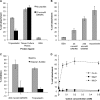Cell adhesion to tropoelastin is mediated via the C-terminal GRKRK motif and integrin alphaVbeta3
- PMID: 19617625
- PMCID: PMC2781405
- DOI: 10.1074/jbc.M109.017525
Cell adhesion to tropoelastin is mediated via the C-terminal GRKRK motif and integrin alphaVbeta3
Abstract
Elastin fibers are predominantly composed of the secreted monomer tropoelastin. This protein assembly confers elasticity to all vertebrate elastic tissues including arteries, lung, skin, vocal folds, and elastic cartilage. In this study we examined the mechanism of cell interactions with recombinant human tropoelastin. Cell adhesion to human tropoelastin was divalent cation-dependent, and the inhibitory anti-integrin alpha(V)beta(3) antibody LM609 inhibited cell spreading on tropoelastin, identifying integrin alpha(V)beta(3) as the major fibroblast cell surface receptor for human tropoelastin. Cell adhesion was unaffected by lactose and heparin sulfate, indicating that the elastin-binding protein and cell surface glycosaminoglycans are not involved. The C-terminal GRKRK motif of tropoelastin can bind to cells in a divalent cation-dependent manner, identifying this as an integrin binding motif required for cell adhesion.
Figures





References
-
- Green L., Humphries M. (1999) Adv. Mol. Cell Biol. 28, 3–26
-
- Newham P., Humphries M. J. (1996) Mol. Med. Today 2, 304–313 - PubMed
-
- Aota S., Nomizu M., Yamada K. M. (1994) J Biol. Chem. 269, 24756–24761 - PubMed
-
- Mithieux S. M., Weiss A. S. (2005) Adv. Protein Chem. 70, 437–461 - PubMed
-
- Ramirez F. (2000) Matrix Biol. 19, 455–456 - PubMed
Publication types
MeSH terms
Substances
LinkOut - more resources
Full Text Sources
Other Literature Sources

